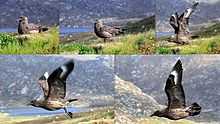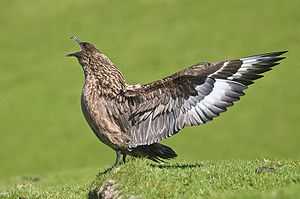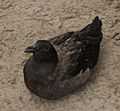Great skua
| Great skua | |
|---|---|
 | |
| Conservation status | |
| Scientific classification | |
| Kingdom: | Animalia |
| Phylum: | Chordata |
| Class: | Aves |
| Order: | Charadriiformes |
| Family: | Stercorariidae |
| Genus: | Stercorarius |
| Species: | S. skua |
| Binomial name | |
| Stercorarius skua Brunnich, 1764 | |
The great skua (Stercorarius skua) is a large seabird in the skua family Stercorariidae. The name skua is believed to originate from the Faroese skúvur and is the only known bird name to originate from the Faroes that has come into regular use elsewhere.[2] In Britain, it is sometimes known by the name bonxie, a Shetland name of Norse origin.[3]
Description
This is a large skua, measuring 50–58 cm (20–23 in) long with a 125–140 cm (49–55 in) wingspan. One study found that 112 males weighed an average of 1.27 kg (2.8 lb) and that 125 females weighed an average of 1.41 kg (3.1 lb).[4] The adult is streaked greyish brown, with a black cap, while the juvenile is a warmer brown and unstreaked below. Its tail is short and blunt. The flight is direct and powerful. The brown skua's call is a harsh hah-hah-hah-hah; quacking and croaking noises have also been heard. Distinguishing this skua from the other North Atlantic skuas (Arctic skua, pomarine skua and long-tailed skua) is relatively straightforward. The herring gull size, massive barrel chest and white wing flashes of this bird are distinctive even at a distance. It is sometimes said to give the impression of a common buzzard (which in America would be called a hawk). Identification of this skua is only complicated when it is necessary to distinguish it from the closely related large southern-hemisphere skuas. Despite its name, the great skua is marginally smaller on average than the other 3 large southern-hemisphere skuas, although not by enough to distinguish them by size in the field.[4] Some authorities still regard the great skua as conspecific with some of these southern skuas, and as a group they have sometimes been separated in the genus Catharacta, although currently this is not commonly followed.

Origins
Genetic studies have found surprising similarities between the great skua and the pomarine skua, despite their dissimilar appearance. Many ornithologists now believe either that the Great Skua originated as a hybrid between the pomarine skua and one of the southern-hemisphere species [Furness and Hamer, 2003], presumably as a result of vagrancy or migration across the equator by the southern species, or that the pomarine skua evolved from hybridization of the great skua and one of the small Arctic species (see Pomarine skua for details).
Breeding
The great skua breeds in Iceland, Norway, the Faroe Islands, and the Scottish islands, with a few on mainland Scotland and in the northwest of Ireland. It breeds on coastal moorland and rocky islands, usually laying two spotted olive-brown eggs in grass-lined nests. Like other skuas, it will fly at the head of a human or other intruder approaching its nest. Although it cannot inflict serious damage, such an experience with a bird of this size is frightening. It is a migrant, wintering at sea in the Atlantic Ocean and regularly reaching North American waters. Vagrant to Mediterranean countries (e.g. Turkey).
Diet
This bird eats mainly fish, birds, eggs, carrion, offal, rodents, rabbits, and occasionally berries. It will often obtains fish by robbing gulls, terns, and even northern gannets of their catches. It will also directly attack and kill other seabirds, up to the size of great black-backed gulls. Like most other skua species, it continues this piratical behaviour throughout the year, showing less agility and more brute force than the smaller skuas when it harasses its victims. A common technique is to fly up to a gannet in mid-air and grab it by the wing, so that it stalls and falls into the sea, where the Great Skua then physically attacks it until it surrenders its catch. Due to its size, aggressive nature and fierce defence of its nest, the great skua has little to fear from other predators. While fledglings can fall prey to rats, cats or the Arctic fox, healthy adults are threatened only by greater raptors such as the golden eagle, the white-tailed eagle, and more rarely by the orca.
Predation account
Unusual behaviour by St Kilda's skuas was recorded in 2007 during research into recent falls in the Leach's storm petrel population. Using night vision gear, ecologists observed the skuas preying on the petrels at night, a remarkable strategy for a seabird.[5]
- Great skua
-

Great skua in water
-

At the Norwegian bird-island Runde
-

At Runde
-

In flight.
-

Captive at Featherdale Wildlife Park, Sydney
-

Captive at Featherdale Wildlife Park, Sydney
Footnotes
- ↑ BirdLife International (2012). "Stercorarius skua". IUCN Red List of Threatened Species. Version 2013.2. International Union for Conservation of Nature. Retrieved 26 November 2013.
- ↑ Salomonsen, F. (1935). Den færøiske ornithologis historie indtil aar 1800 supplement. Dansk Ornithologisk Forenings Tidsskrift, 67–100.
- ↑ Dictionary of the Scots Language. http://www.dsl.ac.uk/entry/snd/bonxie
- ↑ 4.0 4.1 CRC Handbook of Avian Body Masses, 2nd Edition. John B. Dunning Jr. (Editor). CRC Press (2008). ISBN 978-1-4200-6444-5.
- ↑ "Bird night attacks may be unique" (5 November 2007) BBC News. Retrieved 6 November 2007.
References
- Furness, Robert W.; Keith Hamer (2003). "Skuas and Jaegers.". In In Christopher Perrins (Ed.). Firefly Encyclopedia of Birds. Firefly Books. pp. 270–273. ISBN 1-55297-777-3.
- Bull, John; Farrand, Jr., John (April 1984). The Audubon Society Field Guide to North American Birds, Eastern Region. New York: Alfred A. Knopf. ISBN 0-394-41405-5.
External links
| Wikispecies has information related to: Stercorarius skua |
| Wikimedia Commons has media related to Stercorarius skua. |
- More great skua information and photos at the Handa Island Skua Project
- Great Skua videos, photos & sounds on the Internet Bird Collection
